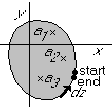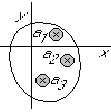D'Alembert and Kutta-Joukowski only apply to bodies in an otherwise uniform stream. If there are other bodies or singularities (vortices, sources, ...) in the fluid, we need to actually integrate Blasius expression. This requires doing a complex contour integral.
We have already seen that the value of a complex contour integral
![]() depends on the singularities of f inside the contour:
In fact, the quickest way to do this sort of integrals is usually
to add the contributions of all the singularities together. These
contributions are called the residues.
depends on the singularities of f inside the contour:
In fact, the quickest way to do this sort of integrals is usually
to add the contributions of all the singularities together. These
contributions are called the residues.
Let the function f have singularities at positions z=a1, z=a2. z=a3, ... inside the contour:


The total integral can be written:
![]()
There are two ways to find the residue at a singular point z=ai:

![]()
Note: To use the residue theorem, function f should only
involve integer powers of ![]() . Broken powers,
logarithms, ... are not acceptable.
. Broken powers,
logarithms, ... are not acceptable.

Exercise:
Evaluatealong circles of radius r=1, 2, 3, ... around the origin. Use Taylor series expansions for the sin and cos to find the Laurent series for the cot.
Exercise:
Evaluatealong circles of radius r=1, 2, 3, ... around the origin. Use the second method above.
As an example, the force on a Rankine body would be difficult to find by actual integration of the pressure. Using Blasius and the residue theorem, it is easy. The velocity potential is (uniform flow, source at z=0, sink at z=e:)
![]()
![]()
![]()
![]()
To find the residue at z=0, we can look at each term separately.
The first, third, and fifth term do not have a residue since they
are not singular at z=0. The second term is a one-term Laurent series
that does not have a 1/z term. The fourth term is a 1/z term
with a coefficient (residue) ![]() . The residue of the
sixth term can be found using the formula above with n=1; it
is
. The residue of the
sixth term can be found using the formula above with n=1; it
is ![]() :
:
![]()
Similarly, at z=e the first, second, and fourth terms are not singular.
The third term is a one-term Laurent series with no 1/(z-e) term.
The fifth term has a residue ![]() , and the sixth has a
residue
, and the sixth has a
residue ![]() :
:
![]()
Since the sum of the residues is zero, there is no net force.
Exercise:
Use Blasius and the residue theorem to find the forces on a cylinder in a uniform stream U that has a circulation. Compare with D'Alembert and Kutta-Joukowski.
You should now be able to do the exercises above.